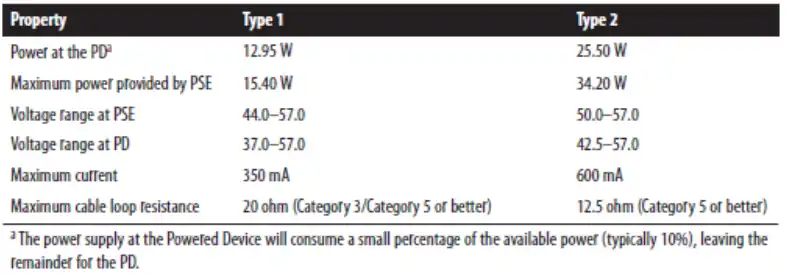Following the main article on Power over Ethernet, and for those who want to delve into the details of this technology, here we discuss PoE device roles and type parameters. If you still don’t know what Power over Ethernet (PoE) is, start by reading the main article.
PoE Device Roles
The PoE standard describes two device roles:
Power Sourcing Equipment (PSE)
The PSE is the device that provides power over a twisted-pair Ethernet cable. A PSE may be an Ethernet switch port, or it can be an outboard power injector.
Powered Device (PD)
The device is powered by the PSE. A Powered Device may include a wireless access point, VoIP telephone, or IP-based security camera. The Powered Device is also called Data Terminal Equipment (DTE) in the standard DTE.
Standard Power Sourcing Equipment provides roughly 48 volts of direct current power to the Powered Device through two pairs of twisted-pair cabling. The following figure shows the two basic methods of sourcing power over Ethernet: endpoint and midspan. With an endpoint PoE device, the Power Sourcing Equipment is also the termination point of the Ethernet link, such as a PoE switch port.

If the switch does not provide power over Ethernet, then an outboard power injector, called a midspan PSE, can be used. Despite the name, the power injector does not have to be located in the middle of the link. Instead, it can be located anywhere along the link that is both convenient and provides an AC power connection, which the midspan PSE converts to DC power for injection into the Ethernet link.
Midspan power injectors typically come in two forms: single port and multiport.
Multiport midspan power injectors provide power to multiple Ethernet devices. This device appears as a box that plugs into AC wall power and converts the wall power into DC power for injection into the Ethernet link. You can also use a single-port midspan injector, which plugs into AC wall power and provides DC power to a single device over an Ethernet link, such as a wireless Ethernet access point.
The figure below shows a PoE splitter. This is a Powered Device that connects to a PoE port and splits out the DC power as a separate connection that is typically based on a round electrical plug that connects to an external device. This makes it possible to provide DC power and Ethernet data over the same cable to a non-PoE device that has an Ethernet connection and a standard DC power plug connection.

PoE Type Parameters
The original PoE standard was defined to provide 12.95 watts at the Powered Device over 100 meters of Category 3 or Category 5 cable. The 802.3at extension provides 25.50 watts at the PD over Category 5 or better cabling. Category 3 cabling is not supported for 802.3at PoE.
To help organize the different specifications, the standard defines two types of Power over Ethernet systems, called Type 1 and Type 2, with different parameters for each.
Type 1 refers to the original, low-power system, and Type 2 refers to the newer system that provides higher power.
The following table shows the key parameters involved in Type 1 and Type 2 PoE power systems.
A “power system” is defined in the standard as a single PSE, link segment, and PD connected together. While Type 1 operation works over old Category 3 cabling and adds no significant requirements to the cabling, Type 2 operation requires Category 5 or better cabling and a derating of the maximum ambient operating temperature for the cabling system.

To learn more about Power over Ethernet you should also read these articles:
- Power over Ethernet (PoE): What is it; Benefits; PoE standards; Devices that may be powered over ethernet.
- How Power over Ethernet Works (PoE Operations)
- PoE and Cable Pairs
- Power over Ethernet Port Management
- PoE Vendor Extensions to the Standard
References and Credits
Ethernet: The Definitive Guide: Designing and Managing Local Area Networks, by Charles E. Spurgeon and Joann Zimmerman (chapter 6)